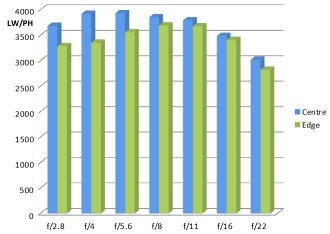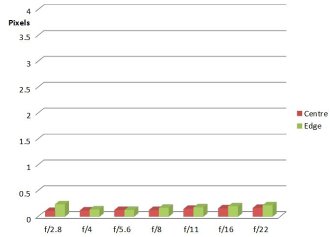Zeiss Milvus 18mm f/2.8 Review
Zeiss Milvus 18mm f/2.8 Performance
Central sharpness starts off as already excellent at f/2.8, rising to outstanding at f/4 and f/5.6. Results are excellent from f/8 to f/16 and remain very good even at f/22. With this lens the smallest aperture is well worth having and fully usable, for situations where we want to maximise depth of field.
The edges are very good at f/2.8, excellent from f/4 through to f/16 and still very good at f/22. The performance is commendably even across the frame and in practice every aperture can be used with confidence.
How to read our charts
The blue column represents readings from the centre of the picture frame at the various apertures and the green is from the edges.The scale on the left side is an indication of actual image resolution as LW/PH and is described in detail above. The taller the column, the better the lens performance.
For this review, the lens was tested on a Nikon D810 using Imatest.
CA (Chromatic Aberration) is very low, both at centre and edge of the image field. This is an exceptionally good performance and further correction in software, whilst possible, will rarely if ever be needed.
How to read our charts
Chromatic aberration is the lens' inability to focus on the sensor or film all colours of visible light at the same point. Severe chromatic aberration gives a noticeable fringing or a halo effect around sharp edges within the picture. It can be cured in software.Apochromatic lenses have special lens elements (aspheric, extra-low dispersion etc) to minimize the problem, hence they usually cost more.
For this review, the lens was tested on a Nikon D810 using Imatest.
The lens exhibits -1.51% of barrel distortion, which is not unexpected. This can be corrected in software, but it can also look perfectly fine in many ultra-wide images. There is less distortion with the Milvus 18mm than with the 15mm previously reviewed.
Flare resistance is excellent, with not a trace of contrast loss or artefacts even when the low sun is right on the edge of the frame.
Bokeh is usually far more obvious in telephoto lenses, so there is no really dramatic effect here. However, with very close subjects it is possible to have some differential focus and the bokeh, the effect on the out of focus background, in these circumstances, seems smooth and pleasant.
The Zeiss Milvus 18mm f/2.8 lens is a lens of the highest calibre and suitable for the most critical work.
Value For Money
The Zeiss Milvus 18mm f/2.8 is priced at £1999, which is the same price as the 15mm previously reviewed.
There are no other 18mm lenses on the market at this time, except of course the Zeiss Classic lens, the 18mm f/3.5 Distagon T*. This is priced at £1089.
This makes for a tough call on value for money, but of course the newer lens does offer moisture and dust sealing, a wider aperture and a revised optical design.
As with all highly priced, high-end lenses, those who feel the need and have the ability to meet the cost will not hesitate to buy. Considering the high performance, the price seems fair.
For more options have a look at the Top 15 Wide-angle Landscape Lenses.
Add your message
Please login here or if you've not registered, you can register here. Registering is safe, quick and free.
photodo Stats
428 MTF tests
74 in-depth photodo reviews
100+ users join each day
Help the lens community by reviewing or rating a lens today via our lens search
Latest Lens Reviews
- Chinon 28mm f/2.8 Vintage Lens Review
- Canon EF 70-200mm f/4L IS II USM Lens Review
- Samyang AF 85mm f/1.4 EF Review
- Sigma 70mm f/2.8 DG Macro Art Review
- Samyang AF 24mm f/2.8 FE Review
- Meike 50mm f/1.7 Review
- Tamron 70-210mm f/4 Di VC USD Review
- Lensbaby Burnside 35mm f/2.8 Review
- Asahi Super Takumar 50mm f/1.4 Review
- Asahi Super-Multi-Coated Takumar 135mm f/3.5 Review


